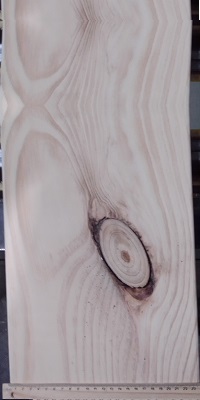Tight Encased Knot: Difference between revisions
Admin wood (talk | contribs) |
Admin wood (talk | contribs) |
||
| Line 40: | Line 40: | ||
== just another file == | == just another file == | ||
ok, scary [[Main Page|main page]] | ok, scary [[Main Page|main page]] | ||
<gallery> | |||
EncasedKnot80mm2.jpg|Caption1 | |||
EncasedKnot80mm2.jpg|Caption2 | |||
EncasedKnot80mm2.jpg|Caption3 | |||
</gallery> | |||
[[File:EncasedKnot80mm2.jpg|left|400px|thumb|Tight Encased Knot]] | |||
Revision as of 01:33, 9 March 2023
Australian Standard Grade Timber
If the Knot has more than 50% cambium, than the size of the not must exceed 20 mm in diameter and no more than 2 such knots are permitted on any piece of timber.
Canadian Standards
A tight encased knot is a type of knot in wood that is surrounded by cambium layer, which is the layer of tissue between the bark and the wood of a tree. This thin layer of bark or cambium serves to encase the knot, providing a protective layer around it.
Despite the presence of this encasing layer, the knot itself remains tight and securely fixed in place within the wood. This type of knot is typically found in trees that have experienced some type of injury or stress, such as wind damage, insect infestation, or disease. When the tree responds to this stress, it may form a knot as a natural part of the healing process.
Tight encased knots can add character and visual interest to wood products, but they can also weaken the wood's overall strength and stability, depending on their location and size. As with all knots, it is important to consider their impact on the quality and integrity of the wood when using them in woodworking projects.
A tight encased knot, also known as an encapsulated knot, is a knot in wood that is completely surrounded by wood and has no opening or visible hole on the surface. This type of knot is generally considered more desirable than an open knot, which has a visible hole or crack that can weaken the wood structure.
Tight encased knots occur when a branch or knot in the tree trunk is completely surrounded by new wood growth. The new wood grows over and around the knot, encasing it within the trunk.
As a tree grows, lower branches often die, and their bases may become overgrown and enclosed by subsequent layers of trunk wood, forming a type of imperfection known as a knot. The dead branch may not be attached to the trunk wood except at its base, and can drop out after the tree has been sawn into boards. Knots affect the technical properties of the wood, usually reducing tension strength, but may be exploited for visual effect. In a longitudinally sawn plank, a knot will appear as a roughly circular "solid" (usually darker) piece of wood around which the grain of the rest of the wood "flows" (parts and rejoins). Within a knot, the direction of the wood (grain direction) is up to 90 degrees different from the grain direction of the regular wood.
In the tree a knot is either the base of a side branch or a dormant bud. A knot (when the base of a side branch) is conical in shape (hence the roughly circular cross-section) with the inner tip at the point in stem diameter at which the plant's vascular cambium was located when the branch formed as a bud.
In grading lumber and structural timber, knots are classified according to their form, size, soundness, and the firmness with which they are held in place. This firmness is affected by, among other factors, the length of time for which the branch was dead while the attaching stem continued to grow.
Wood knot in vertical section
Knots materially affect cracking and warping, ease in working, and cleavability of timber. They are defects which weaken timber and lower its value for structural purposes where strength is an important consideration. The weakening effect is much more serious when timber is subjected to forces perpendicular to the grain and/or tension than when under load along the grain and/or compression. The extent to which knots affect the strength of a beam depends upon their position, size, number, and condition. A knot on the upper side is compressed, while one on the lower side is subjected to tension. If there is a season check in the knot, as is often the case, it will offer little resistance to this tensile stress. Small knots, however, may be located along the neutral plane of a beam and increase the strength by preventing longitudinal shearing. Knots in a board or plank are least injurious when they extend through it at right angles to its broadest surface. Knots which occur near the ends of a beam do not weaken it. Sound knots which occur in the central portion one-fourth the height of the beam from either edge are not serious defects. —
Knots do not necessarily influence the stiffness of structural timber, this will depend on the size and location. Stiffness and elastic strength are more dependent upon the sound wood than upon localized defects. The breaking strength is very susceptible to defects. Sound knots do not weaken wood when subject to compression parallel to the grain.
This is a header
more of the header later
now that the header is produced
produced by header producer
this is more content
nice feature
this is even more content
one more content
another file
here is the extension
just another file
ok, scary main page

